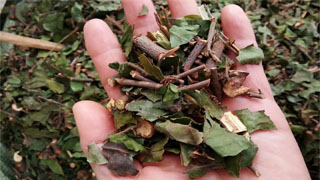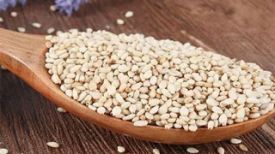
Nickname: Parasitic on Mulberry
Harvesting and processing: Harvesting from winter to the next spring, removing thick stems, cutting sections and drying, or steaming and drying.
Medicinal parts: Stem branches with leaves
Origin: Fujian, Guangdong, Guangxi
Family: Mulberry Parasitic Family
Original plant: Mulberry Parasite (Broad Parasite)
Plant condition: Shrubs
0.5-1m high. The tender branches and leaves are densely covered with rust colored star shaped hairs, sometimes with sparse overlapping star shaped hairs, and later become hairless; Twigs gray brown, with small pores.
Leaves grow opposite or near opposite; The petiole length is 8-10mm; Leaves thick paper, ovate to long ovate, 2 5-6cm, 1.5-4cm wide, rounded and blunt tip, wedge-shaped or broadly wedge-shaped base; 3-4 pairs of lateral veins, slightly noticeable.
Umbelliferae inflorescence, 1-2 axillary or on deciduous axils of small branches, with 1-4 flowers, usually 2 flowers, inflorescence and perianth stellate hairs, total peduncle length 2-4mm; The flower stem is 6-7mm long; Bract scales; Flower brown; Receptacle elliptical or ovoid; Circular calyx; The flower bud of the corolla is tubular, measuring 2.5-2.7cm in length, slightly curved, with the lower half swollen, the top ovoid, with 4 lobes, spoon shaped, and folded; The filaments are 2/3 shorter than the anthers, and the anthers have transverse septa; Cup shaped flower disk; The style is linear, and the stigma is head shaped.
Berries are elliptical or nearly spherical in shape, with dense small nodules on the skin that are sparsely hairy. Mature fruits are light yellow in color, measuring up to 1cm in length, and the skin becomes smooth. The flowering and fruiting period is from April to January of the following year.
Characteristics of Mulberry Parasitic Medicinal Materials: The stems and branches are cylindrical, measuring 3-4cm in length and 0 in diameter. 2~1cm; The surface is reddish brown or grayish brown, with fine longitudinal lines and many small raised brown pores. Some tender branches have visible brown hairs; Hard texture, uneven cross-section, reddish brown skin, lighter wood color. Leaves are often curled and have short stems; After flattening, the leaves take on an oval or elliptical shape, measuring 3-8cm in length and 2-5cm in width; The surface is yellow brown, the young leaves are covered with fine hairs, the tip is blunt and round, the base is round or broadly wedge-shaped, and the entire margin; Transformed. Odorless and astringent in taste.
The superior products are those with fine branches, tender texture, reddish brown color, and many leaves.
Poor quality products are not parasitic on mulberry trees and are considered inferior
Mulberry parasitic medicinal properties:
The parasitic taste on the mulberry tree in this sutra is bitter and flat. It mainly affects lower back pain, strong back in children, abscesses and swelling, prevents miscarriage, nourishes the skin, strengthens teeth, and has long eyebrows and beard. In fact, it can improve vision, lighten the body, and invigorate the mind. It can also absorb debris and hide wood
Bitter taste, calm qi, enters the Foot Shaoyin Kidney and Foot Jueyin Liver Meridian. Strengthen bones and muscles, stop bleeding and promote lactation.
Mulberry parasitism can penetrate the meridians, expel dampness and rheumatism, treat lower back pain, strong back, weak tendons and bones, blood collapse and milk closure, fetal movement and abdominal pain, dysentery, and golden sores and carbuncles. Strong teeth and long eyebrows.
【 Origin 】 It can be found everywhere in Guangxi, China, but there are more parasitic trees and fewer parasitic mulberry trees.
[Taste] Bitter in taste, mild in nature, non-toxic.
【 Indications 】 Mulberry parasitism is a medicinal herb used to tonify the liver, kidneys, muscles, and bones. It is effective in treating lower back pain and strengthening the back, promoting blood circulation, preventing miscarriage, and treating female internal injuries, miscarriage, and postpartum complications.
[Additional Record] Women with insufficient internal injuries, postpartum residual diseases, lactation, main sores, and rheumatism.
【 Rongchuan 】 This medicine has a sour taste and dense branches, with a woody nature. It grows on top of mulberry trees, where the metal in the wood parasitizes and attaches to it. Therefore, it can only obtain the qi between the metal and wood, and its roots are not clay. It is purely sensitive to the wind and is therefore an essential medicine for dispersing wind and wood. This medicine is born with wood attached to it, resembling the gallbladder attached to the liver. It has a sour and bitter taste and is infused with the scent of wood fire. It can clear the fire in the liver and gallbladder, treat wind heat, muscle and vein knots, and other symptoms. The gallbladder connects to the omentum of the three burners and is externally attached to the tendons, parasitizing like vines attached to wood and resembling human tendons. Therefore, it is used for treatment.
[Zhen Quan] The main pregnancy leaked blood continuously, making the fetus firm.
【 Spiritual Embryo 】 Drive the wind, nourish the blood, and ensure the safety of the fetus.
[Dosage] Normally one to three yuan.
[Taboo] Avoid seeing fire.
[Processing] Remove impurities, wash slightly, moisten thoroughly, cut into thick slices, and dry.
[Taste] Bitter, sweet, flat.
Return to the liver and kidney meridians.
【 Indications and Functions 】 Tonifying the liver and kidneys, strengthening muscles and bones, dispelling wind and dampness, and stabilizing the fetus. Used for rheumatoid arthritis, soreness and weakness of the waist and knees, weakness of muscles and bones, excessive menstrual bleeding, pregnancy bleeding, and fetal instability; hypertension.
【 Usage and Dosage 】 9-15g.
[Storage] Store in a dry place to prevent decay.
【 Note 】 (1) It is most suitable for rheumatism and rheumatism, liver and kidney deficiency, and waist and knee pain, and is often used in combination with Duhuo, Achyranthes, and other ingredients. For elderly people with physical weakness, women with excessive menstrual flow and insufficient liver and kidney function, lower back and knee pain, and muscle and bone weakness, it is also used in combination with Eucommia ulmoides and Dipsacus. It is used for fetal blood leakage and fetal movement uneasiness caused by deficiency of liver and kidney, weak Chong and Ren, and is often compatible with Dipsacus asper, dodder, ass hide glue, etc. In addition, this product has a blood pressure lowering effect and has been commonly used in bed for hypertension in recent years. "


